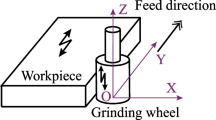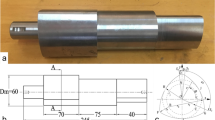Abstract
This paper presents an experimental and theoretical study of surface generation in the ultra-precision grinding of hard and brittle materials. The study takes into account the material properties, the relative vibration between the grinding wheel and the workpiece, the machining parameters and the phase shift of the grinding process. The Taguchi approach is employed to study the influence of machining parameters on the surface quality and shows that the feed speed and rotational speed of the workpiece are key factors. Experiments have been conducted to study individual variables, and the results further show that the feed rate and the cross-feed distance have a significant effect on surface generation. It is found that the spirals around the central area of the workpiece are the primary mechanism for surface generation, which originates from the synchronous relative tool-work vibration. The integral part of the ratio of the rotational speed of the grinding wheel to rotational speed of the workpiece determines the number of spirals and its fractional part controls the spiral geometry. A theoretical model for predicting the single spiral generation has been developed to explain the accumulation of the phase shift and the geometry. The changeable feed speed near the end of grinding is also modelled, revealing the approximate straight lines around one circle in the central region. The simulated results indicate that the theoretical models and the ground surfaces are in close agreement. The scallop-height model is developed to calculate the influence of phase shift on surface quality, and it is found that the phase shift near the medium value can effectively improve surface quality. Finally, a comparison of different surface generation mechanisms in grinding mould steel, tungsten carbide (WC) and reaction bonded silicon carbide (RB-SiC) is made. It is interesting to note that the Spanzipfel effect contributes to the surface generation not only on ductile materials such as mould steel but also on brittle materials such as WC and RB-SiC. The Spanzipfel effect is the most significant in grinding mould steel. For WC and RB-SiC, the ground surface contains both a ductile region and a brittle region in the form of micro-fractures.
Similar content being viewed by others
References
Agarwal S, Rao PV (2012) Predictive modeling of undeformed chip thickness in ceramic grinding. Int J Mach Tools Manuf 56:59–68
Beaucamp A, Simon P, Charlton P, King C, Matsubara A, Wegener K (2017) Brittle-ductile transition in shape adaptive grinding (SAG) of SiC aspheric optics. Int J Mach Tools Manuf 115:29–37
Jahanmir S, Ramulu M, Koshy P (1999) Machining of ceramics and composites. Marcel Dekker, New York
Zhang QL, To S, Zhao QL, Guo B, Zhang GQ (2015) Impact of material microstructure and diamond grit wear on surface finish in micro-grinding of RB-SiC/Si and WC/Co carbides. Int J Refract Met Hard Mater 51:258–263
Agarwal S, Rao PV (2010) Grinding characteristics, material removal and damage formation mechanisms in high removal rate grinding of silicon carbide. Int J Mach Tools Manuf 50:1077–1087
Yin L, Huang H (2008) Brittle materials in nano-abrasive fabrication of optical mirrorsurfaces. Precis Eng 32:336–341
Zhang B, Zheng XL, Tokura H, Yoshikawa M (2003) Grinding induced damage in ceramics. J Mater Process Technol 132(1–3):353–364
Lee SC, Ren N (1996) Behavior of elastic-plastic rough surface contacts as affected by surface topography, load, and material hardness. Tribol Trans 39(1):67–74
Stark GA, Moon KS (1999) Modeling surface texture in the peripheral milling process using neural network, spline, and fractal methods with evidence of chaos. ASME J Manuf Sci Eng 121(2):251–256
Huang H, Yin L, Zhou LB (2003) High speed grinding of silicon nitride with resin bond diamond wheels. J Mater Process Technol 141(3):329–336
Zhang QL, To S, Zhao QL, Guo B (2016) Surface generation mechanism of WC/Co and RB-SiC/Si composites under high spindle speed grinding (HSSG). Int J Refract Met Hard Mater 56:123–131
Kwak J (2005) Application of Taguchi and response surface methodologies for geometric error in surface grinding process. Int J Mach Tools Manuf 45(3):327–334
AllorRL, WhalenTJ, BaerJR, KumarKV (1993)Machining of silicon nitride: experimental determination of process/property relationships Proceedings of International Conference on Machining Adv Mater223–234
Oliveira JFG, Botteneand AC, França TV (2001) A novel dressing technique for texturing of ground surfaces. Annals of the CIRP—Manufacturing Technology 59:361–364
Ohbuchi Y, Obikawa T (2006) Surface generation model in grinding with effect of grain shape and cutting speed. JSME Int J Ser C Mech Syst Mach Elem Manuf 49(1):114–120
Agarwal S, Rao PV (2005) A new surface roughness prediction model for ceramic grinding. Proc Inst Mech Eng B J Eng Manuf 219(11):811–819
Warnecke G, Zitt U (1998) Kinematic simulation for analyzing and predicting high-performance grinding processes. Ann CIRP 47(1):265–270
Cao YL, Guan JY, Li B, Chen XL, Yang JG, Gan CB (2013) Modeling and simulation of grinding surface topography considering wheel vibration. Int J Adv Manuf Technol 66(5):937–945
Jiang XH, Guo MX, Li BZ (2018) Active control of high-frequency tool-workpiece vibration in micro-grinding. Int J Adv Manuf Technol 94(1):1429–1439
Yan Y, Xu J, Wiercigroch M (2016) Regenerative chatter in self-interrupted plunge grinding. Meccanica 51(12):3185–3202
Hassui A, Diniz AE (2003) Correlating surface roughness and vibration on plunge cylindrical grinding of steel. Int J Mach Tools Manuf 43(8):855–862
Yoshihara N, Kuriyagawa T, Syoji K (2003) Formation of vertical striped pattern on the ground surface in high-reciprocation profile grinding (in Japanese). Journal of the Japan Society for Precision Engineering 67(8):1316–1320
Cao HR, Dörgeloh T, Riemer O, Brinksmeier E (2017) Adaptive separation of unbalance vibration in air bearing spindles. Procedia CIRP 62:357–362
Marinescu I, Rowe W, Dimitrov B, Ohmori H (2013) Tribology of abrasive machining processes, 2nd edn. Elsevier, Amsterdam
Chen JB, Fang QH, Li P (2015) Effect of grinding wheel spindle vibration on surface roughness and subsurface damage in brittle material grinding. Int J Mach Tools Manuf 91:12–23
Kuriyagawa T, Yoshihara N, Saeki M, Syoji K (2003) Nano-topography characterization of axisymmetric aspherical ground surfaces. Key Eng Mater 238-239:125–130
Yoshihara N, Yan JW, Kuriyagawa T (2008) Control of nano-topography on an axisymmetric ground surface. Key Eng Mater 389-390:96–101
Whitehouse DJ (1994) Handbook of surface metrology. Institute of Physics Pub, Bristol
Gill R (1986) An investigation into the effect of the ratio of grinding wheel speed to workpiece speed in the centreless grinding process. In: Coventry. Lanchester) Polytechnic, PhD thesis
Horvath M, Kundrak J, Mamalis A, Gyani K (2002) On the precision grinding of advanced ceramics. Int J Adv Manuf Technol 20(4):255–258
Pandit SM, Sathyanarayanan G (1984) Data-dependent systems approach to surface generation in grinding. ASME J Eng Ind 106(3):205–212
Pandit SM, Revach SS (1981) A data dependent systems approach to dynamics of surface generation in turning. ASME J Eng Ind 103(4):437–445
Funding
The work was supported by a PhD studentship (project account code: RU3K) from The Hong Kong Polytechnic University. This research work was also supported by the State Key Basic Research and Development Program, China (973 program, Grant No. 2011CB 013202), and Guangdong Provincial Department of Science and Technology, Guangdong, P.R. China, for The Introduction of Innovative R&D Team Program of Guangdong Province (project no.: 201001G0104781202).
Author information
Authors and Affiliations
Corresponding author
Rights and permissions
About this article
Cite this article
Chen, S.S., Cheung, C.F. & Zhang, F.H. An experimental and theoretical analysis of surface generation in the ultra-precision grinding of hard and brittle materials. Int J Adv Manuf Technol 97, 2715–2729 (2018). https://doi.org/10.1007/s00170-018-2121-8
Received:
Accepted:
Published:
Issue Date:
DOI: https://doi.org/10.1007/s00170-018-2121-8




